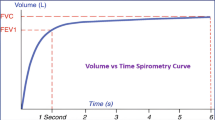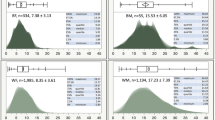Abstract
In this work detection of pulmonary abnormalities carried out using flow-volume spirometer and Radial Basis Function Neural Network (RBFNN) is presented. The spirometric data were obtained from adult volunteers (N = 100) with standard recording protocol. The pressure and resistance parameters were derived using the theoretical approximation of the activation function representing pressure–volume relationship of the lung. The pressure–time and resistance–expiration volume curves were obtained during maximum expiration. The derived values together with spirometric data were used for classification of normal and obstructive abnormality using RBFNN. The results revealed that the proposed method is useful for detecting the pulmonary functions into normal and obstructive conditions. RBFNN was found to be effective in differentiating the pulmonary data and it was confirmed by measuring accuracy, sensitivity, specificity and adjusted accuracy. As spirometry still remains central in the observations of pulmonary function abnormalities these studies seems to be clinically relevant.




Similar content being viewed by others
References
Pierce, R., Spirometer: An essential clinical measurement. Aust. Fam. Physician. 34:535–539, 2005.
David, A. G., and Fan Chung, K., Models of chronic obstructive pulmonary disease. Respir. Res. 5:1–16, 2004.
Nicholas, J. G., Chronic obstructive pulmonary disease outcome measurements what’s important? what’s useful? Proc. Am. Thorac. Soc. 2:267–271, 2005.
Hogg, J. C., Chu, F., Utokaparch, S. et al., The nature of small-airway obstruction in chronic obstructive pulmonary disease. N. Engl. J. Med. 350:2645–2653, 2004.
Oud, M., and Maarsingh, E. J. W., Spirometer and forced oscillatory assisted optimal frequency band determination for the computerized analysis of tracheal lung sounds in asthma. Physiol. Meas. 25:595–606, 2004.
Cooper, B. G., and Madsen, F., Buy. Inspir. 3:40–43, 2000.
Suga, H., and Sagawa, K., Instantaneous pressure–volume relationship and their ratio in the excised, supported canine left article. Circ. Res. 34:117, 1974.
Barnea, O., Abboud, S., Guber, A., and Bruderman, I., Model-based prediction of expiratory resistance index in patients with asthma. J. Clin. Monit. Comput. 18:241–245, 2004.
Abboud S., Barnea O., Guber A., Narkiss N., and Bruderman I., Maximum expiratory flow–volume curve: Mathematical model and experimental results. Med. Eng. Phys. 17:332–336, 1995.
Sriraam, N., and Eswaran, C., Context based error modeling for lossless compression of EEG signals using neural networks. J. Med. Syst. 30:439–448, 2006.
Ng, E. Y. K., and Sai-Cheong, F., A Framework for early discovery of breast tumor using thermography with artificial neural network. Breast J. 9:341–343, 2003.
Kornel, P., Bela, M., Rainer, S., Zalan, D., Zsolt, T., and Janos, F., Application of neural network in medicine. Diagn. Med. Technol. 4:538–546, 1998.
Gaetano, P., Artificial neural network in the assessment of respiratory mechanism. Dissertations from faculty of medicine. University of Upsaliensis: Uppsala, 2004.
Nicolaos, B. K., and Mary, M. R., On the construction and training of reformulated radial basis function neural networks. IEEE Trans. Neural Netw. 14:835–846, 2003.
Chen, T., and Chen, H., Approximation capability to functions of several variables, nonlinear functionals, and operators by radial basis function neural networks. IEEE Trans. Neural Netw. 6:904–910, 1995.
Botis, T., and Halkiotis, S., Neural networks for the prediction of spirometric reference values. Med. Inform. Internet Med. 28:299–309, 2003.
Juroszek, B., The influence of gas parameters on the result of spirometric test. Meas. Sci. Rev. 5:25–28, 2005.
Feyrouz, A., Reena, M., and Peter, J. M., Interpreting pulmonary function tests: Recognize the pattern, and the diagnosis will follow. Clevel. Clin. J. Med. 70:866–881, 2003.
Zheng, R. Y., A novel radial basis function neural network for discriminant analysis. IEEE Trans. Neural Netw. 17:604–612, 2006.
Wei, Q., Kenneth, S. M. F., Francis, H. Y. C., Lan, F. K., Paul, W. F. P., and Roger, P. H., Adaptive filtering of evoked potentials with radial-basis function neural network prefilter. IEEE Trans. Biomed. Eng. 49:225–232, 2002.
Rakesh, K. S., Yogender, A., and Barda, N. D., Backpropagation artificial neural network detects changes in electro-encephalogram power spectra of syncopic patients. J. Med. Syst. 31:63–68, 2007.
Joon, L., Stefanie, B., Mike, J. C., David, J. K., Glenn, B., and Tom, C., A radial basis classifier for the automatic detection of aspiration in children. JNER. 3:1–17, 2006.
Tchervensky, I. V., De Sobral Cintra, R. J., Neshev, E., Dimitrov, V. S., Sadowski, D. C., and Mintchev, M. P., Center-specific multichannel electrogastrographic testing utilizing wavelet-based decomposition. Physiol. Meas. 27:569–584, 2006.
Mahesh, V., and Ramakrishnan, S., Assessment and classification of normal and restrictive respiratory conditions through pulmonary function test and neural network. J. Med. Eng. Technol. 31:300–304, 2007.
Ulmer, W. T., Lung function—Clinical importance, problems, and new results. J. Physiol. Pharmacol. 54:11–13, 2003.
Enright, P. L., Studnicka, M., and Zielinski, J., Spirometry to detect and manage chronic obstructive pulmonary disease and asthma in primary care settings. Eur. Resp. Monit. 31:1–14, 2005.
Acknowledgement
The authors would like to thank Dr. R. Sridharan for his help in clinical data collection.
Author information
Authors and Affiliations
Corresponding author
Rights and permissions
About this article
Cite this article
Veezhinathan, M., Ramakrishnan, S. Detection of Obstructive Respiratory Abnormality Using Flow–Volume Spirometry and Radial Basis Function Neural Networks. J Med Syst 31, 461–465 (2007). https://doi.org/10.1007/s10916-007-9085-9
Received:
Accepted:
Published:
Issue Date:
DOI: https://doi.org/10.1007/s10916-007-9085-9




